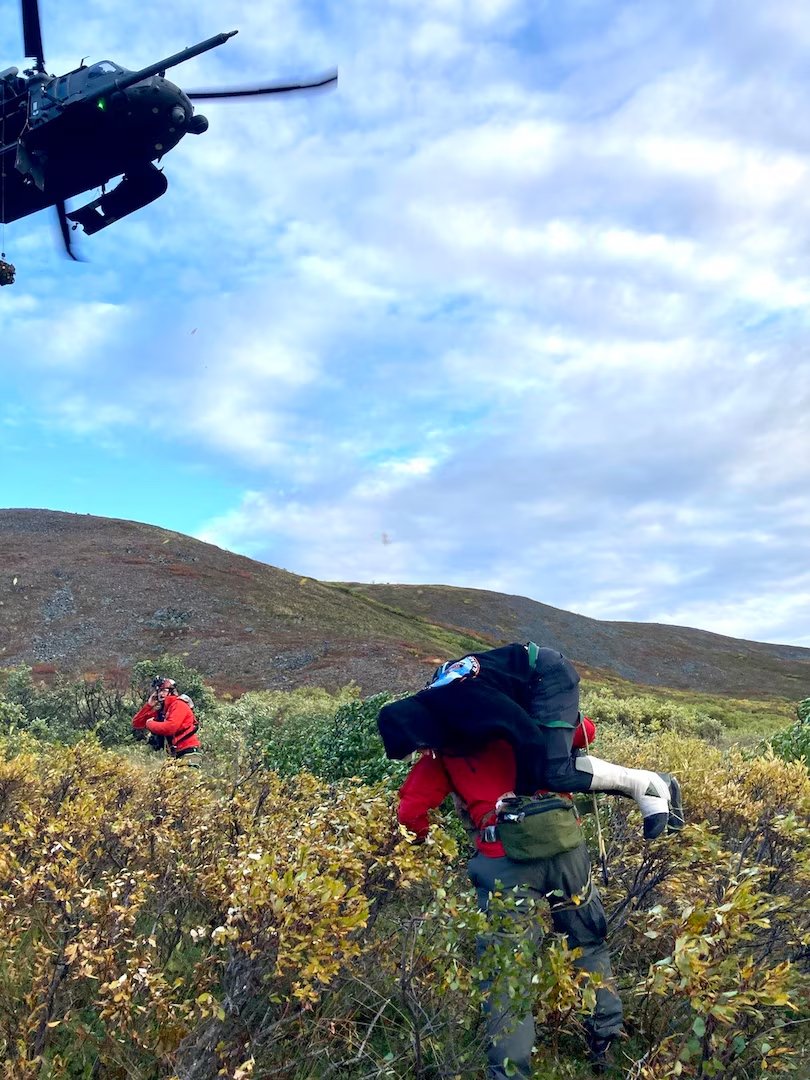Alaska Air Guard Rescues Plane Crash Victims, Hikers, Hunter
NEWS | Sept. 9, 2024
Alaska Air Guard Rescues Plane Crash Victims, Hikers, Hunter
By Maj. David Bedard, Alaska National Guard
JOINT BASE ELMENDORF-RICHARDSON, Alaska - Alaska Air National Guard 176th Wing members rescued eight distressed residents in five missions over the Labor Day Weekend.
Two of the missions required 212th Rescue Squadron Guardian Angels to parachute from an HC-130J Combat King II.
The missions started Aug. 30 when the Alaska Rescue Coordination Center received notice of two concurrent plane crashes. The first crash site, near Skwentna, had an isolated, uninjured survivor needing rescue. The second aircraft, 50 miles southwest of Tok, had two survivors with life-threatening injuries.
The AKRCC requested assistance from the 176th Wing. The 176th Operations Group search and rescue duty officer, Alaska Air National Guard Lt. Col. Gavin Johnson, dispatched a 211th Rescue Squadron HC-130, two 210th Rescue Squadron HH-60G Pave Hawk helicopters and 212th Guardian Angels on each aircraft.
The first HH-60G crew rerouted inflight during their return trip from Eielson Air Force Base, located the uninjured pilot near Skwentna, and transported him to Alaska State Troopers at Birchwood Airport.
Launching around the same time, an HC-130 and HH-60 with Guardian Angels on board took off from JBER to the second crash site 50 miles southwest of Tok. Two of the crew involved in the crash had reported life-threatening injuries.
The HC-130 pushed forward to the crash site ahead of the HH-60G and released three Guardian Angels with Double Bag Static Line parachutes directly overhead the incident site. The DBSL is a steerable square-shaped parachute system that packs both the main and reserve parachutes in one bag, and it deploys from a metal static line inside the Combat King. The HC-130 aircrew performed this maneuver in a single pass within minutes of arrival overhead.
The Guardian Angels landed their parachutes within a few feet of the survivors trapped inside the aircraft. They freed them, rendered advanced life support and prepared them to be hoisted to the helicopter. The HC-130 then diverted to aerial refuel and provide weather reconnaissance for the HH-60 to return to the crash site for recovery. With the survivors hoisted out and Guardian Angels on board, the HH-60 provided critical care to the patients while transporting them to Anchorage hospitals.
Alaska Air National Guard Maj. Dan Warren, combat rescue officer and team commander of the Guardian Angel element that parachuted to both Aug. 30 and 31 crash sites, explained the decision to deploy by parachute rather than by helicopter.
“The patients’ extent of injuries versus the time and distance required to reach them drives our tactics to respond,” Warren said. “Parachuting is simply another means to expedite our access to patient care, which is why we train on it weekly.”
Warren highlighted the importance of quick response to plane crashes that often include life-threatening injuries.
“What is remarkable is the speed in which the 210th, 211th and 212th Rescue Squadrons were able to respond and execute this complex maneuver,” he said. “We had parachutes over our heads and bandaging wounds inside of an hour after takeoff. That level of operational efficiency can only be earned after years of flying missions together.”
On Aug. 31, AKRCC received notification of a third plane crash about 160 miles northwest of Anchorage.
Bystanders near the crash site reported life-threatening injuries to the pilot. Johnson dispatched the same HH-60G, HC-130 and Guardian Angel crews. Due to the extent of the injuries reported, the HC-130 crew and Guardian Angel team flew directly to the crash site on a 2,500-foot ridge. The Guardian Angels, led by Warren, parachuted into the crash site for their second jump in 24 hours
The Guardian Angels determined the pilot wouldn’t survive. The HH-60G Pave Hawk landed soon after to recover the team and the pilot. The HH-60G then rescued a stranded hunter nearby en route to JBER.
On Sept. 1 and 2, Johnson dispatched HH-60 crew and Guardian Angels to rescue distressed hikers in Denali National Park 10 miles north of Cantwell. The hikers were picked up and handed off to the National Park Service and Alaska State Troopers.
Johnson said 176th Wing rescue Airmen are always eager to help fellow Alaskans, but he expressed regret at the loss of the pilot.
“It is always a tough day for the Alaskan aviation community any time we lose one of our own,” he said. “Our heartfelt condolences and our prayers go out for his family and loved ones.”

